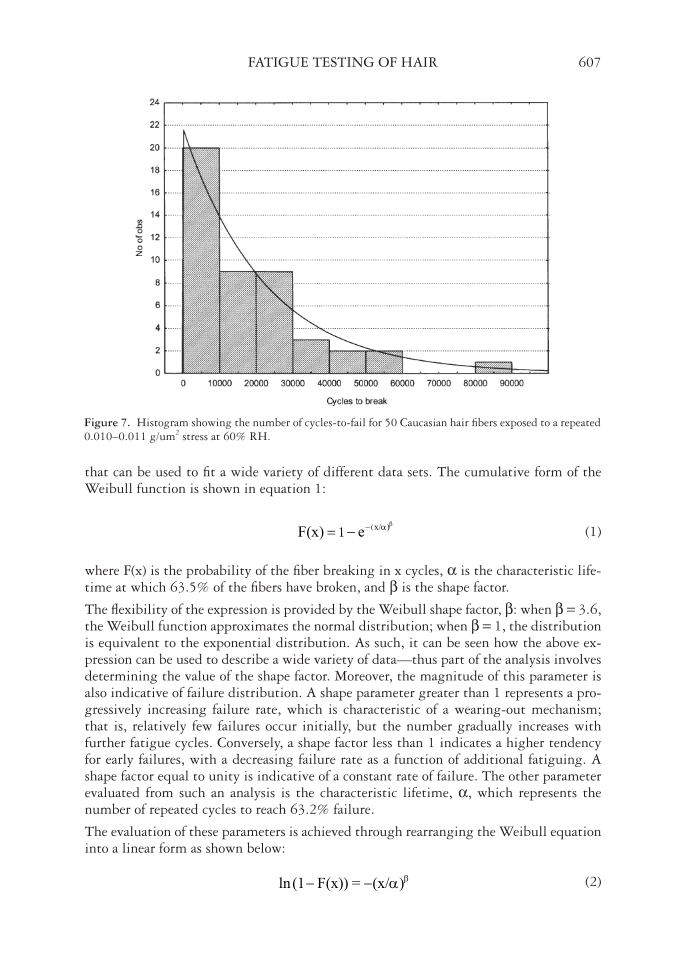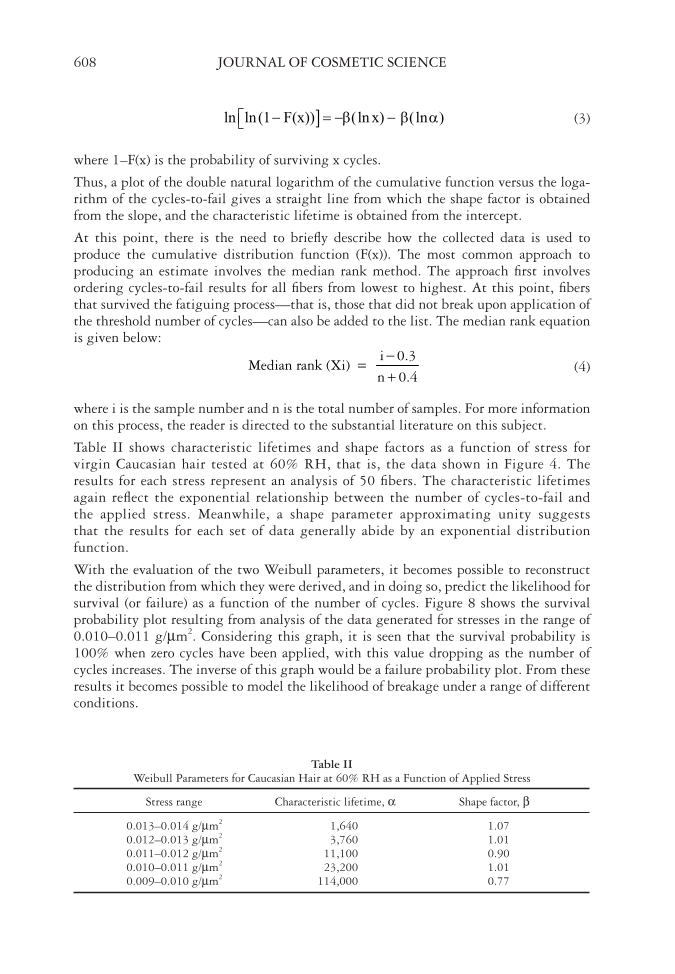FATIGUE TESTING OF HAIR 607 that can be used to fi t a wide variety of different data sets. The cumulative form of the Weibull function is shown in equation 1: F(x) e (x/DE 1 (1) where F(x) is the probability of the fi ber breaking in x cycles, α is the characteristic life- time at which 63.5% of the fi bers have broken, and β is the shape factor. The fl exibility of the expression is provided by the Weibull shape factor, β: when β = 3.6, the Weibull function approximates the normal distribution when β = 1, the distribution is equivalent to the exponential distribution. As such, it can be seen how the above ex- pression can be used to describe a wide variety of data—thus part of the analysis involves determining the value of the shape factor. Moreover, the magnitude of this parameter is also indicative of failure distribution. A shape parameter greater than 1 represents a pro- gressively increasing failure rate, which is characteristic of a wearing-out mechanism that is, relatively few failures occur initially, but the number gradually increases with further fatigue cycles. Conversely, a shape factor less than 1 indicates a higher tendency for early failures, with a decreasing failure rate as a function of additional fatiguing. A shape factor equal to unity is indicative of a constant rate of failure. The other parameter evaluated from such an analysis is the characteristic lifetime, α, which represents the number of repeated cycles to reach 63.2% failure. The evaluation of these parameters is achieved through rearranging the Weibull equation into a linear form as shown below: ln (1 F(x)) = (x/DE (2) Figure 7. Histogram showing the number of cycles-to-fail for 50 Caucasian hair fi bers exposed to a repeated 0.010–0.011 g/um2 stress at 60% RH.
JOURNAL OF COSMETIC SCIENCE 608 @ ln ln(1 F(x)) lnx) lnD ª E E (3) where 1–F(x) is the probability of surviving x cycles. Thus, a plot of the double natural logarithm of the cumulative function versus the loga- rithm of the cycles-to-fail gives a straight line from which the shape factor is obtained from the slope, and the characteristic lifetime is obtained from the intercept. At this point, there is the need to briefl y describe how the collected data is used to produce the cumulative distribution function (F(x)). The most common approach to producing an estimate involves the median rank method. The approach fi rst involves ordering cycles-to-fail results for all fi bers from lowest to highest. At this point, fi bers that survived the fatiguing process—that is, those that did not break upon application of the threshold number of cycles—can also be added to the list. The median rank equation is given below: i 0.3 Median rank (Xi) n 0.4 = (4) where i is the sample number and n is the total number of samples. For more information on this process, the reader is directed to the substantial literature on this subject. Table II shows characteristic lifetimes and shape factors as a function of stress for virgin Caucasian hair tested at 60% RH, that is, the data shown in Figure 4. The results for each stress represent an analysis of 50 fi bers. The characteristic lifetimes again refl ect the exponential relationship between the number of cycles-to-fail and the applied stress. Meanwhile, a shape parameter approximating unity suggests that the results for each set of data generally abide by an exponential distribution function. With the evaluation of the two Weibull parameters, it becomes possible to reconstruct the distribution from which they were derived, and in doing so, predict the likelihood for survival (or failure) as a function of the number of cycles. Figure 8 shows the survival probability plot resulting from analysis of the data generated for stresses in the range of 0.010–0.011 g/μm2. Considering this graph, it is seen that the survival probability is 100% when zero cycles have been applied, with this value dropping as the number of cycles increases. The inverse of this graph would be a failure probability plot. From these results it becomes possible to model the likelihood of breakage under a range of different conditions. Table II Weibull Parameters for Caucasian Hair at 60% RH as a Function of Applied Stress Stress range Characteristic lifetime, α Shape factor, β 0.013–0.014 g/μm2 1,640 1.07 0.012–0.013 g/μm2 3,760 1.01 0.011–0.012 g/μm2 11,100 0.90 0.010–0.011 g/μm2 23,200 1.01 0.009–0.010 g/μm2 114,000 0.77
Purchased for the exclusive use of nofirst nolast (unknown) From: SCC Media Library & Resource Center (library.scconline.org)

































































































